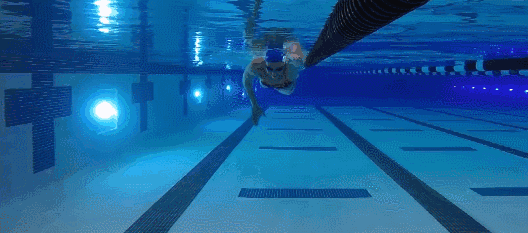你有沒有看過自由泳的電影?現在視頻分析風靡一時,而且有充分的理由:當你減慢中風時,可以將其分成幾個部分,找出需要調整的地方。這有助於確定哪些單項演習將有助於提高整體效率。
提高游泳效率的第一步是減少阻力。你可能會創造比你想像的更多的游泳拖動。游泳運動員干涉他們在水中的前進運動有很多方法。這裡有三種最常見的自由式錯誤,以及幫助您學習如何更快游泳的練習。
手臂交叉
許多游泳運動員最終在中線橫過雙臂,降低了他們的捕捉效果(游泳者「抓住」水並將其拉回的中風部分),並使他們的肩膀更容易受傷。
在旱地上試試這個:把你的右臂舉到空中。你的手應該直接射到你的肩膀上方的空氣中 – 不要漂浮在你的頭上或者偏向一邊。這是你在中風時應遵循的路線。
修復它演習:將多組演習融入每次鍛煉中,您只需將注意力集中在手臂上。一些運動員到達池邊,但有時會導致過度補償。
更好的是,如果你有自己的車道,直接在黑線上游泳。在每個衝程中保持每條臂在黑線的相應側。在這次演習中,抬起頭部比平時更高,以監視手臂的動作。在你的呼吸衝程中要特別注意,因為這是你最容易交叉的時候。
推動反對水
在中風的前端,你的手指指向或向下?為了在中風前端達到全面延伸,游泳運動員通常將手伸向手掌向前的位置。這創造了一面牆,它推動水而不是切透水。
修復它鑽:放鬆你的手腕。讓手指在整個中風中輕輕hang拉。注意你的手指和手掌,確保它們不向上。
激進的踢
你是否試圖通過更強的踢球來補償臀部下沉或上半身不良?你踢得越硬,越容易漂浮,越快越好,對吧?錯誤。當你為彌補可憐形式而進行的補償時,你會浪費能量抬高你的下半身,而不是推動自己前進。
另外,如果你有一個非常積極的踢,你可能會創造更多的游泳拖動比推進。總沉浸式游泳教練Jan Javier比較它在走路時擺動雙臂。你的手臂自然而然地擺動著你的腿,這有助於保持穩定和動力。在水中,你想要捕捉到自然的反向流動。
修復它:練習:在每次訓練中加入幾圈使用魚鰭。游泳腳蹼會誇大踢腳,並迫使您減慢腳步,並使每次踢腳有目的。它們還可以幫助你更好地感受你的腿部和腳部應該如何穿過水麵。
一定要通過你的腳趾從臀部一直踢,並且踢起來也一樣。
Have you ever watched yourself swim freestyle on film? Video analysis is all the rage these days, and for good reason: When you slow down your stroke, you can break it into several segments and figure out where you need to make adjustments. This helps determine which individual drills will help improve your overall efficiency.
The first step toward more efficient swimming is to reduce drag. You might be creating more swim drag than you think. There are a number of ways swimmers interfere with their own forward movement in the water. Here are three of the most common freestyle mistakes, and drills to help you learn how to swim faster.
Arm Crossover
A lot of swimmers end up crossing their arms over the center line, decreasing the effectiveness of their catch (the part of the stroke where the swimmer “catches” the water and pulls it back) and making their shoulders more susceptible to injury.
Try this on dry land: Raise your right arm into the air. Your hand should shoot straight up into the air directly above your shoulder — not float over your head or off to the side. This is the line you should follow in your stroke.
Fix it Drill: Incorporate several sets of drills into each workout where you focus solely on your arms. Some athletes reach for the corners of the pool, although that sometimes results in overcompensation.
Better yet, if you have a lane to yourself, swim directly over the black line. Keep each arm on its respective side of the black line throughout each stroke. Lift your head higher than usual during this drill to monitor your arm movements. Pay particularly close attention during your breathing strokes as this is when you’re most susceptible to crossing over.
Pushing Against the Water
At the front end of your stroke, are your fingers pointed up or down? In an effort to reach full extension on the front end of the stroke, swimmers often flex their hands to the point where their palms are facing forward. This creates a wall that, pushes against, rather than slices through, the water.
Fix it Drill: Relax your wrists. Let the fingers hang limply throughout the entire stroke. Watch your fingers and palms to make sure they don’t point upward.
Aggressive Kick
Do you try to compensate for sinking hips or poor upper body form with a stronger kick? The harder you kick, the easier it will be to stay afloat and the faster you’ll go, right? Wrong. When you kick to compensate for poor form, you waste energy lifting your lower half up, rather than propelling yourself forward.
Also, if you have a really aggressive kick, you might be creating more swim drag than propulsion. Total Immersion swim coach Jan Javier compares it to swinging your arms when walking. Your arms naturally swing opposite from your legs, which helps maintain stability and momentum. In the water, you want to capture that natural, opposing flow.
Fix it Drill: Incorporate a few laps using swim fins into each workout. Swim fins exaggerate the kick and force you to slow it down and make each kick purposeful. They also help you get a better feel for how your legs and feet should move through the water.
Be sure to kick from the hips all the way through your toes, and kick up as well as down.
